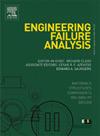残余应力在高温条件下工作的过热器铬钼钢管弯曲失效中的作用
IF 4.4
2区 工程技术
Q1 ENGINEERING, MECHANICAL
引用次数: 0
摘要
本研究涉及铬钼钢过热器弯曲点的材料分析。锅炉运行 4 300 h 后,在弯曲内侧出现裂缝,导致工作介质泄漏,设备被迫停机。锅炉的运行参数如下:蒸汽输出压力 3.2-3.6 MPa,蒸汽输出温度 440-450 °C。在过热器下管弯曲处的侧表面发现了裂纹。为确定损坏原因,进行了目视、显微和 EDS SEM 分析。显微分析表明,裂纹起始点位于管子内表面最大弯曲处附近,此处存在的凹坑起到了应力集中器的作用。EDS 扫描电子显微镜证实,腐蚀层中主要的铁含量与腐蚀坑上方形成的小瘤有关,这些小瘤参与了失效的腐蚀-机械性质。计算得出的残余应力值很大,且集中在钢管的内侧和外侧弯曲区域。利用有限元模型(FEM)确定了钢管弯曲后的应力分布,并证实弯曲后的残余应力、蒸汽压力和温度以及钢管点蚀共同导致了裂纹的形成和扩展。通过电子反向散射衍射(EBSD)分析,对过热钢管壁厚横截面上的局部机械应力分布进行了实验。获得的结果与米塞斯残余应力相关联。本文章由计算机程序翻译,如有差异,请以英文原文为准。
Role of residual stress in the failure of the bend of superheater Cr-Mo steel tube working in high-temperature conditions
This study deals with the material analysis of a Cr-Mo steel superheater at the bending point. The crack occurred on the inside of the bend after 4,300 h of boiler operation, which resulted in a leak of the working medium and a forced device shutdown. The planned service life of the superheater tubes was 34,000 h. The operating parameters of the boiler were as follows: steam output pressure 3.2–3.6 MPa, steam output temperature 440–450 °C. Cracks were found on the lateral surfaces of the bends of the superheater lower tubes. Visual, microscopic, and EDS SEM analyses were performed to determine the cause of the damage. Microscopic analysis showed that crack initiation occurred near the maximum bend on the inner surface of the tubes, where the present pits acted as stress concentrators. EDS SEM confirmed that the predominant iron content in the corrosion layer was related to the formation of tubercles above the corrosion pits, which participated in the corrosion-mechanical nature of the failure. The calculated residual stress values were significant and concentrated in both the intrados and extrados bending regions of the tube. Finite element model (FEM) was used to locate the post-bending stress distribution of the tube and confirmed that a combination of post-bending residual stresses, steam pressure and temperature, and steel tube pitting caused cracks to form and propagate. The distribution of local mechanical stresses through a cross-section of the wall thickness of the superheated tube was experimentally carried out using an electron backscattered diffraction (EBSD) analysis. The obtained results were correlated with the Mises residual stress.
求助全文
通过发布文献求助,成功后即可免费获取论文全文。
去求助
来源期刊

Engineering Failure Analysis
工程技术-材料科学:表征与测试
CiteScore
7.70
自引率
20.00%
发文量
956
审稿时长
47 days
期刊介绍:
Engineering Failure Analysis publishes research papers describing the analysis of engineering failures and related studies.
Papers relating to the structure, properties and behaviour of engineering materials are encouraged, particularly those which also involve the detailed application of materials parameters to problems in engineering structures, components and design. In addition to the area of materials engineering, the interacting fields of mechanical, manufacturing, aeronautical, civil, chemical, corrosion and design engineering are considered relevant. Activity should be directed at analysing engineering failures and carrying out research to help reduce the incidences of failures and to extend the operating horizons of engineering materials.
Emphasis is placed on the mechanical properties of materials and their behaviour when influenced by structure, process and environment. Metallic, polymeric, ceramic and natural materials are all included and the application of these materials to real engineering situations should be emphasised. The use of a case-study based approach is also encouraged.
Engineering Failure Analysis provides essential reference material and critical feedback into the design process thereby contributing to the prevention of engineering failures in the future. All submissions will be subject to peer review from leading experts in the field.
 求助内容:
求助内容: 应助结果提醒方式:
应助结果提醒方式:


